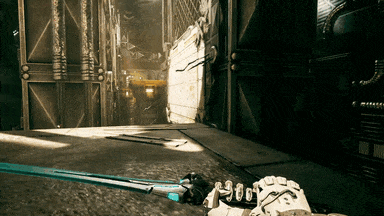This past weekend at PAX East, The Outerhaven had the distinct pleasure of playing Ghostrunner, the next project from One More Level Games. It’s no surprise this game commanded attention at the show floor this year: the game’s pulse-pounding cyberpunk action was both mechanically satisfying and viscerally amusing in all the right ways. Cliche comparison aside, Ghostrunner truly is a unique and exciting experience that deserves high praise.
[videopress ZBhJMs0W]Avenge the Fallen
The premise for Ghostrunner is prime cyberpunk fanfare: players take on the role of the elite “Ghostrunner” assassin, seeking revenge and answers for why the Ghostrunner is the last of his kind. Humanity has been reduced to a micro-society housed within a giant tower in the center of a dilapidated city, forced to survive together after an unknown cataclysm wiped out modern society. The tower city’s caste-like civilization dictates a person’s social status at birth through implants placed in all citizens. Breaking out of prison, the titular protagonist must ascend the monolithic tower that houses humanity’s last bastion in order to stop the mysterious “Keymaster.” Guided only by “The Whisper,” a mysterious artificial intelligence that re-awakens the Ghostrunner, players must avoid being hunted by the Keymaster’s soldiers and seek revenge on the Keymaster’s reign.
It’s hard not to get Matrix vibes from Ghostrunner, but the similarities end with the base story beats. Playing Ghostrunner is the best part about this game.
Conquer Your Enemies
Ghostrunner‘s intensive gameplay moments are all about momentum and lethality, on behalf of both the player and your enemies. There is no defined health mechanic in the game, meaning players die in one hit, but enemies are killed in one hit (at least in the most current demo, that is). The idea behind Ghostrunner is that players must perfect their skills and usage of the in-game mechanics to make the perfect run through a level, evoking that try/try again desire felt in games like Hotline Miami or SUPERHOT.
Players have access to one weapon throughout the entirety of Ghostrunner: their sweet-looking cyber sword. Ghostrunner‘s sword has a surprising amount of range and can tear enemies in half with ease. That’s not to say the weapon still doesn’t require precision, as each slash of the sword still has plenty of lag if the player misses their opponent. Attacking enemies is generally a variant of a horizontal slash, and because combat is built on the “glass cannon” mantra, there are no combos of any kind. Instead, Ghostrunner‘s combat is based solely on strategically maneuvering around enemies to land that satisfying hit to kill enemies gracefully. Again, player precision is vastly important in Ghostrunner.
Zooming Around
Building off that is the fantastic traversal in Ghostrunner. Players can run, slide, dash, climb, wall-run, and swing across the battlefield, with each motion producing speed and momentum. The movement mechanics encourage players to keep moving at all times, as each variant of movement outside of standard running allows the character to move even faster. Ghostrunner has a distinct verticality to its environmental design, meaning players aren’t going to be spending most of their time grounded.
There’s a distinct smoothness in how the player connects to walls for wall-running, sliding down sloped roofs, or dashing around projectiles. The fluidity in transition between each movement types acts like a fluid but tame version of Titanfall wall-running and movement speeds. What sets Ghostrunner apart from other movement systems is that the game manages to enact restraint on player momentum in small but effective ways. There’s no physics manipulations like “bunny-hopping” in the game, meaning players have to react reflexively to their environment. Landing in the wrong spot or dashing just shy of a wall will end all movement momentum almost immediately. It’s not exactly punishing but is moderated in a way that feels appropriately challenging.
Humanity’s Last Remaining Shelter
The world Ghostrunner explores exemplifies all these gameplay mechanics in fantastic ways. The high contrast neons placed alongside rustic metals reeks of a futuristic, cyberpunk-riddled world filled with character. The city itself being a tower justifies the aforementioned vertical design concepts used in crafting the environments of Ghostrunner. Aside from the fact that it’s cool to play as a parkouring badass cybernetic assassin, the world actually justifies this use of super-human acrobatics. People’s homes are stacked on top of one another alongside monolithic, brutalist structures that scream “societal oppression.” With humanity forced into such a small space, it makes sense for the city to be so condensed and vertical. Perfect for a Ghostrunner to traverse.
Become the Living Weapon
Overall, what makes Ghostrunner distinctive is the fact that it encourages creativity and perfection through a seemingly sparse selection of abilities. Upon first glance it may look as though only being able to use one weapon is extremely limiting, but in reality the elements that complement the Ghostrunner’s sword are what makes the game so special. Using just the sword forces players to think strategically and reflexively, discovering what the best route is through a scenario and executing the plan. Being reckless in Ghostrunner is punishing, and rightfully so, but planning and executing a run through a packed environment is extremely satisfying. And with the few story beats in the demo hinting at heroes and villains being much more ambiguous in this world, it’ll be interesting to see what fate lies for the Ghostrunner in the future.
This won’t be the last time we hear from Ghostrunner, as this game deserves all the attention it got at PAX this year. It’ll be exciting to see what’s in store for this game when it’s planned to release later on in 2020.





